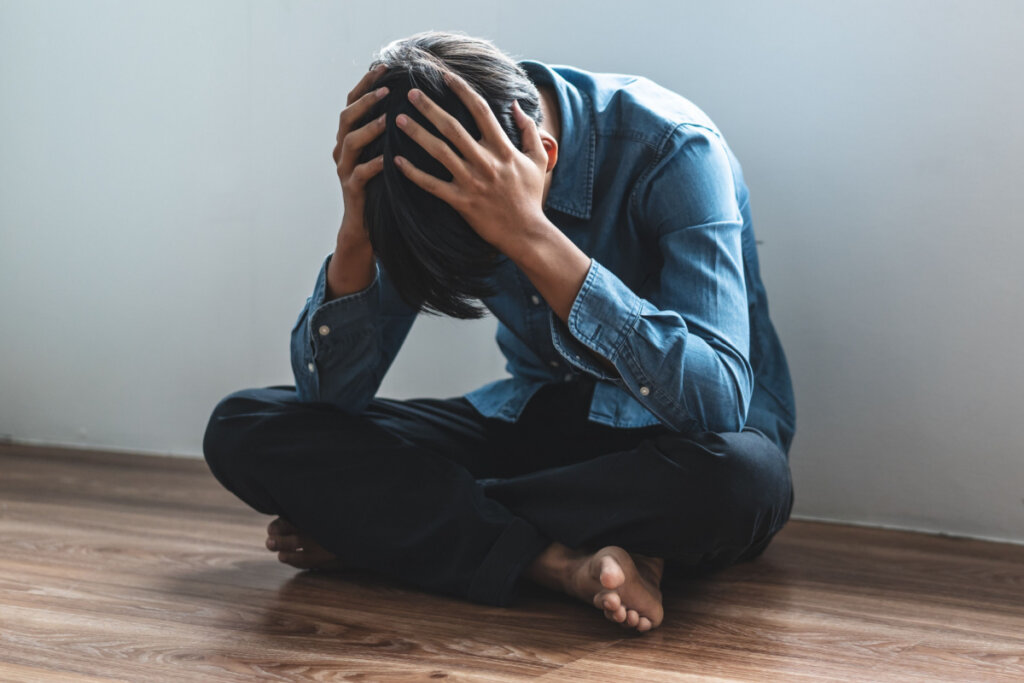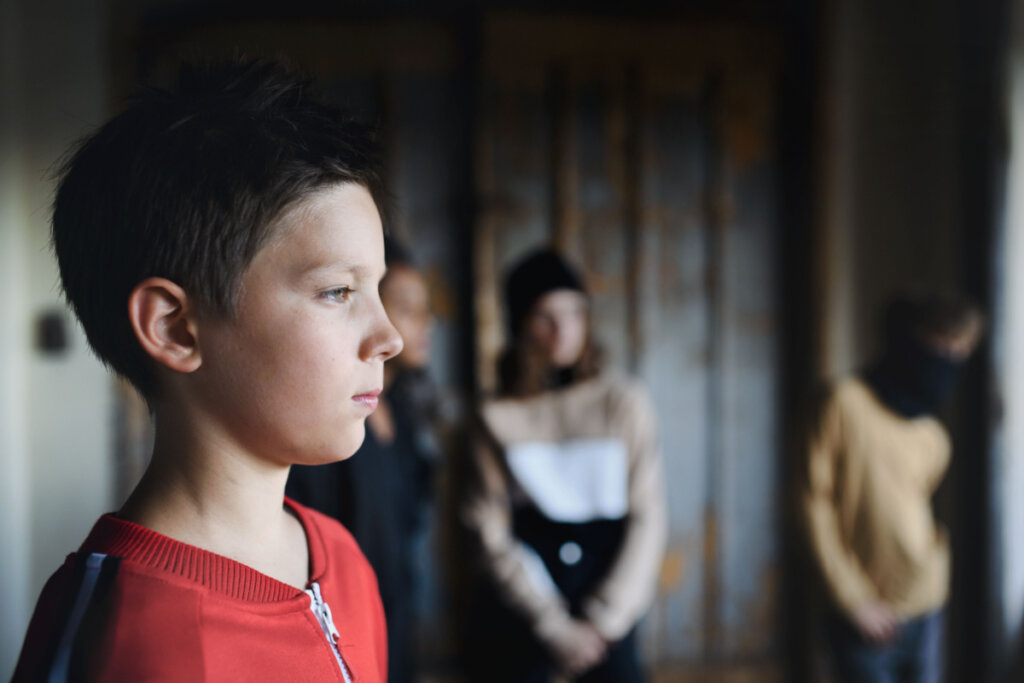The Relationship Between Bullying and Adolescent Mental Health


Written and verified by the psychologist Sara González Juárez
The relationship between bullying and adolescent mental health is one of the most studied topics today. Although bullying has been around forever, priority is finally being given to creating an environment of respect in educational institutions.
However, eradicating a type of violence exercised by people whose self-construction process is still in progress is complicated. Moreover, bullying isn’t violence that concerns only the victim and the bully. It also encompasses spectators, schools, families, and, of course, society itself.
We must be clear about the consequences of bullying on the mental health of adolescents. This is what we’re going to talk about here. Indeed, becoming aware of the implications of bullying is the key to ending it, once and for all.

The link between bullying and the mental health of the victim
Firstly, we must analyze the mental health of adolescent victims of bullying. They bear the brunt of the bullying and the indifference of everyone else.
- Both bullying and cyberbullying have a positive relationship with the deterioration of self-esteem, as indicated by multiple studies.
- This implies self-doubt, insecurity, and difficulties in social relationships.
- There’s also a direct relationship between being a victim of bullying and presenting symptoms of anxiety and depression. For instance, somatizations, intense sadness, and isolation.
- This correlation is also significant for other conditions, such as eating disorders (TCA).
- Research shows that depression can bridge the gap between bullying and suicidal behavior. Adolescent women are more affected in this regard.
- Victims of bullying show intense feelings of loneliness and helplessness.
Psychological effects of being a bully
We often leave the bully out of the equation because we tend to focus on protecting the victim. However, we shouldn’t forget that they’re also individuals who act according to certain learning, values, and stimuli. Indeed, the spiral of bullying begins with the bully, so they also need to be worked with. These are the characteristics of the typical bully:
- Their empathy deteriorates due to their bullying. They get what they want through aggression. Moreover, they tend to victimize themselves and feel no guilt.
- They lack social skills and assertiveness.
- They suffer symptoms of anxiety. These are often accompanied by feelings of insecurity and dissatisfaction with life.
- They exhibit high impulsivity. This pushes them to develop antisocial behaviors.
- They’ve often also been the victim of abusive behaviors.
- They exhibit poor emotional management, both of their own feelings and those of others.
- There’s a high correlation between being a bully in high school and displaying highly antisocial behaviors in adult life.
Understanding the roots of bullying behavior is key to addressing mental health consequences in adolescents. It’s where the work to prevent this form of violence must begin.
Consequences for spectators of bullying
The figure of the spectator who exhibits permissiveness in the face of acts of violence, is also part of the phenomenon of bullying. Moreover, their mental health is also affected.
- Research claims that witnesses of school violence experience anxiety, stress, and fear during the events, supporting either the victim or the bully.
- They manifest feelings of guilt at their own permissiveness, but fear prevents them from acting.
- Through observation, they learn behavior patterns based on a dominance and submission style.
- They form part of the normalization of violence in the school environment.
- These factors create adults who participate in forms of violence indirectly. They either perpetuate it through their acquired values or remain indifferent to their experiences in everyday life.

What to do in the case of bullying?
According to a study conducted by Save the Children in 2016, 33 percent of the surveyed sample admitted to having recently physically assaulted someone. Not only that: one out of ten had threatened and 50 percent had insulted another person. And, 25 percent had done the same thing on social media. As a matter of fact, this data suggests that one in three students claimed to have been on the receiving end of some type of aggression.
As you can see, it’s impossible not to come across examples of aggression in school environments. Moreover, many of them escalate into incidences of bullying and deteriorating adolescent mental health. This creates a world of adults accustomed to violence.
If you see someone being bullied, don’t participate. The family and the educational institution need to be told since they’re responsible for stopping the process and taking measures such as preventive programs. Afterward, they should seek professional psychological help for the victim and those around them, including the bully.
Stopping bullying is a systemic task that concerns everyone one of us, as part of society. Violence can never become a culture. Otherwise, we’ll all become victims.
The relationship between bullying and adolescent mental health is one of the most studied topics today. Although bullying has been around forever, priority is finally being given to creating an environment of respect in educational institutions.
However, eradicating a type of violence exercised by people whose self-construction process is still in progress is complicated. Moreover, bullying isn’t violence that concerns only the victim and the bully. It also encompasses spectators, schools, families, and, of course, society itself.
We must be clear about the consequences of bullying on the mental health of adolescents. This is what we’re going to talk about here. Indeed, becoming aware of the implications of bullying is the key to ending it, once and for all.

The link between bullying and the mental health of the victim
Firstly, we must analyze the mental health of adolescent victims of bullying. They bear the brunt of the bullying and the indifference of everyone else.
- Both bullying and cyberbullying have a positive relationship with the deterioration of self-esteem, as indicated by multiple studies.
- This implies self-doubt, insecurity, and difficulties in social relationships.
- There’s also a direct relationship between being a victim of bullying and presenting symptoms of anxiety and depression. For instance, somatizations, intense sadness, and isolation.
- This correlation is also significant for other conditions, such as eating disorders (TCA).
- Research shows that depression can bridge the gap between bullying and suicidal behavior. Adolescent women are more affected in this regard.
- Victims of bullying show intense feelings of loneliness and helplessness.
Psychological effects of being a bully
We often leave the bully out of the equation because we tend to focus on protecting the victim. However, we shouldn’t forget that they’re also individuals who act according to certain learning, values, and stimuli. Indeed, the spiral of bullying begins with the bully, so they also need to be worked with. These are the characteristics of the typical bully:
- Their empathy deteriorates due to their bullying. They get what they want through aggression. Moreover, they tend to victimize themselves and feel no guilt.
- They lack social skills and assertiveness.
- They suffer symptoms of anxiety. These are often accompanied by feelings of insecurity and dissatisfaction with life.
- They exhibit high impulsivity. This pushes them to develop antisocial behaviors.
- They’ve often also been the victim of abusive behaviors.
- They exhibit poor emotional management, both of their own feelings and those of others.
- There’s a high correlation between being a bully in high school and displaying highly antisocial behaviors in adult life.
Understanding the roots of bullying behavior is key to addressing mental health consequences in adolescents. It’s where the work to prevent this form of violence must begin.
Consequences for spectators of bullying
The figure of the spectator who exhibits permissiveness in the face of acts of violence, is also part of the phenomenon of bullying. Moreover, their mental health is also affected.
- Research claims that witnesses of school violence experience anxiety, stress, and fear during the events, supporting either the victim or the bully.
- They manifest feelings of guilt at their own permissiveness, but fear prevents them from acting.
- Through observation, they learn behavior patterns based on a dominance and submission style.
- They form part of the normalization of violence in the school environment.
- These factors create adults who participate in forms of violence indirectly. They either perpetuate it through their acquired values or remain indifferent to their experiences in everyday life.

What to do in the case of bullying?
According to a study conducted by Save the Children in 2016, 33 percent of the surveyed sample admitted to having recently physically assaulted someone. Not only that: one out of ten had threatened and 50 percent had insulted another person. And, 25 percent had done the same thing on social media. As a matter of fact, this data suggests that one in three students claimed to have been on the receiving end of some type of aggression.
As you can see, it’s impossible not to come across examples of aggression in school environments. Moreover, many of them escalate into incidences of bullying and deteriorating adolescent mental health. This creates a world of adults accustomed to violence.
If you see someone being bullied, don’t participate. The family and the educational institution need to be told since they’re responsible for stopping the process and taking measures such as preventive programs. Afterward, they should seek professional psychological help for the victim and those around them, including the bully.
Stopping bullying is a systemic task that concerns everyone one of us, as part of society. Violence can never become a culture. Otherwise, we’ll all become victims.
All cited sources were thoroughly reviewed by our team to ensure their quality, reliability, currency, and validity. The bibliography of this article was considered reliable and of academic or scientific accuracy.
- Save the Children. (2016, febrero). Yo a eso no juego. Recuperado 1 de febrero de 2023, de https://www.savethechildren.es/sites/default/files/imce/docs/yo_a_eso_no_juego.pdf
- Tejerina Chica, Y. L. (2020). Educación Emocional como medida preventiva ante el suicidio. Propuesta de intervención frente al bullying desde el Trabajo Social en centros educativos del Principado de Asturias.
- Adelardi, L., & Conductual, O. T. C. Bullying, gordofobia y salud mental.
- Azúa Fuentes, E., Rojas Carvallo, P., & Ruiz Poblete, S. (2020). Acoso escolar (bullying) como factor de riesgo de depresión y suicidio. Revista chilena de pediatría, 91(3), 432-439.
- Alvarez-Quiroz, G. B., Martelo, M. F. G., Alcalá, S. P. A., González, R. D. Z., & Márquez, N. I. S. (2023). Relación entre bullying, ciberbullying y autoestima: prevalencia y factores asociados en adolescentes deMiranda, R., Oriol, X., Amutio, A., & Ortúzar, H. (2019).
- Bullying en la adolescencia y satisfacción con la vida: ¿puede el apoyo de los adultos de la familia y de la escuela mitigar este efecto?. Revista de Psicodidáctica, 24(1), 39-45. Colombia. Zona Próxima, (38), 88-109.
- Evans, C. B., Smokowski, P. R., Rose, R. A., Mercado, M. C., & Marshall, K. J. (2019). Cumulative bullying experiences, adolescent behavioral and mental health, and academic achievement: An integrative model of perpetration, victimization, and bystander behavior. Journal of child and family studies, 28, 2415-2428.
- Sanmartín, P. G. (2019). Bullying: una puerta de entrada a la conducta antisocial adulta. EHQUIDAD. Revista Internacional de Políticas de Bienestar y Trabajo Social, (11), 151-202.
- Vitero, F. B. (2021). Combatir el bullying para evitar el maltrato en la vida adulta y otras conductas desadaptadas. Revista INFAD de Psicología. International Journal of Developmental and Educational Psychology., 2(2), 93-98.
- Arias Mallo, S. (2022). Influencia del bullying sobre los trastornos de la conducta alimentaria en la adolescencia: proyecto de investigación.
This text is provided for informational purposes only and does not replace consultation with a professional. If in doubt, consult your specialist.







